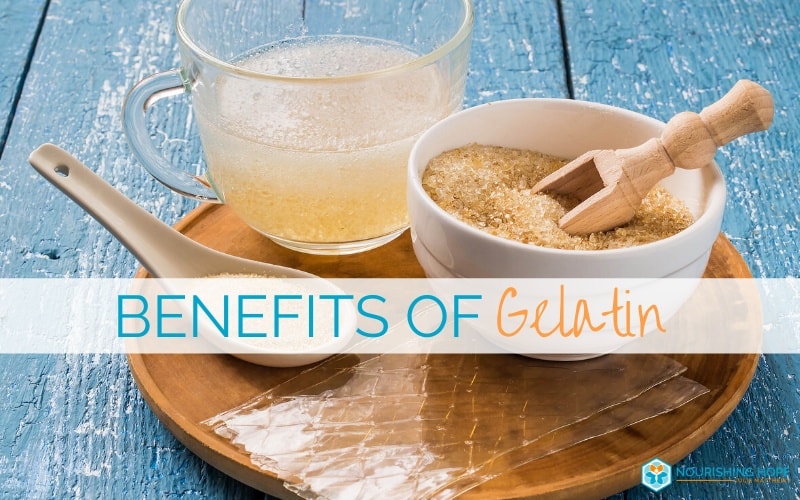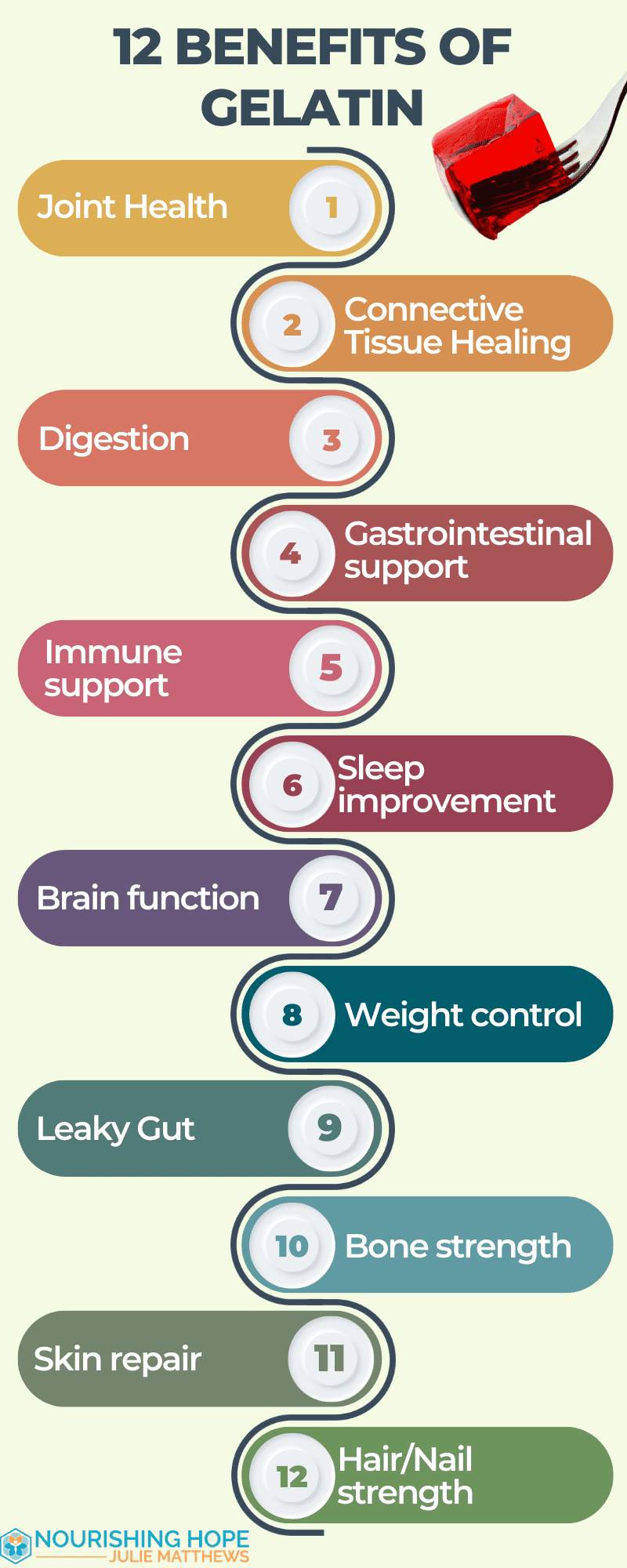
What is Gelatin Exactly?
Simply, gelatin is COOKED collagen. Gelatin is the basic ingredient is used to make foods “gel”. Gelatin is found in bone broth, but also manufactured into a powder/granulated form and added to make gummies, gelatin desserts, and more. This form of collagen is used most often in foods and recipes.
Gelatin vs. Collagen
So, then what is collagen?
Collagen is the most abundant and key structural and “fibrous” protein in your body. Collagen is critical for the quality and strength of your skin, gut integrity, connective tissue, bones, cartilage, tendons, ligaments, and joints. It literally holds you together. To consume collagen, we get it from our diets, primarily from animals and fish, as it is found in their tougher parts (skin, bones, hooves, etc). When we cook those tough parts, as in making broth, the “tough” collagen becomes gelatin.
There’s another part to the collagen/gelatin story, and that is hydrolyzed (aka hydrolysate) collagen. Hydrolyzed means to break down by chemical reaction with water. This process causes the proteins to be broken down into amino acids. This form is mainly used as a supplement and is said to be more easily digested than gelatin form because it is additionally broken down.
So, in summary, collagen is the base, and it can be turned into 2 different products: Gelatin and Hydrolyzed Collagen.
The difference? Gelatin “gels” and only dissolves in hot liquid, where hydrolyzed collagen does not gel, and thus can dissolve in hot or cold liquid. Also, hydrolyzed collagen is more easily digested as it is broken down further. As a supplement, hydrolyzed collagen can make a great addition to smoothies, juices, tea, and even water, where gelatin may not work as well in for those applications.
What is the same between these two? Like gelatin, hydrolyzed collagen is also completely flavorless and can be added to any liquid.
Gelatin and collagen both contain a similar amino acid profile.
Amino acids
The biggest benefit of gelatin is its amino acid profile. Gelatin is 98% protein by dry weight. Due to this, there are a number of amino acids donated to your body by consuming quality gelatin. Of those, glycine and proline very high, as well as hydroxyproline, glutamic acid, alanine, arginine, aspartic acid, lysine.
Glycine, glutamic acid, and cysteine make up glutathione, the body’s master antioxidant.
It’s important to be aware that gelatin does not have a complete amino acid profile so it is not a full amino acid/protein supplement.
However, the amino acids in gelatin have specific benefits to our bodies.
12 Benefits of Gelatin
What are the benefits? The list is long! Gelatin’s amino acids donate building materials to help grow and repair our body structure and recover from injuries as well as improve digestive and cognition troubles. Here are a few of the most commonly known benefits:
 Joint health – Beneficial for cartilage and tissue to help relieve pain such as arthritis, by stalling inflammatory responses.
Joint health – Beneficial for cartilage and tissue to help relieve pain such as arthritis, by stalling inflammatory responses.- Connective tissue healing – Promotes healing of injuries and exercise recovery.
- Digestion – Improves gut health along with digestion/absorption,
- Gastrointestinal support – Stimulates stomach acids and natural digestive enzymes, which may lessen acid reflux and bloating and indigestion.
- Immune support – the gut is critical to immune health, with digestive juices, microbiome, protective tight junctions to keep pathogens from being absorbed, so when you improve gut health, immune function benefits as a result.
- Sleep improvement – certain studies have shown gelatin to perhaps be linked to improved sleep quality and quicker time to fall asleep. The benefits of sleep numerous.
- Brain function – gelatin also shows to improve mood and cognition as glycine is one of the amino acids that acts as an calming neurotransmitter in the brain.
- Weight control – can help to increase satiety and thus control hunger hormones.
- Leaky Gut – gelatin has been used successfully with diets that focus on leaky gut and gut healing, such as in the SCD and GAPS diets.
- Bone strength – Adds bone supporting minerals to help bone repair as well as to lessen bone weakness and degrading as we age. It acts as a safe therapeutic agent for osteoarthritis and osteoporosis.
- Skin repair – Adds elasticity and hydration for wrinkle reduction and improve skin repair and protects from free radicals and thus potentially reduces risk of skin damage.
- Hair/Nail strength – Improving strength and growth of these areas with amino acid building blocks also can correct hair loss.
Gelatin Gummies
So if you’d like to add more gelatin to your diet, check out my delicious and fun recipe that kids and adults alike enjoy.
Here’s my recipe for Gelatin Hearts.
 These fun heart-shaped treats are great for any holiday.
These fun heart-shaped treats are great for any holiday.
The ingredients not only do not include any refined sugars, but there are some rock stars in there, and gelatin is at the top of the list!
- Gelatin – Grass Fed, stocked with amino acids to help build and repair our body structures
- Water – so many benefits of pure water
- Coconut milk – especially helpful if dairy is not tolerated
- Juice – homemade or unsweetened pure – watermelon, strawberry, black cherry, etc
- Honey – great sugar alternative, especially when local and not pasteurized
- Vanilla Extract – helps add a “sweetness” without additional sugar, as well as naturally flavor your treats
You could ADD hydrolyzed collagen powder to the recipe, to get even more peptides which are easy to digest, but you still need to use gelatin to get the jello type of result.
Please share your favorite gelatin recipes and your stories of success using gelatin to help heal in the comments below..



0 Comments